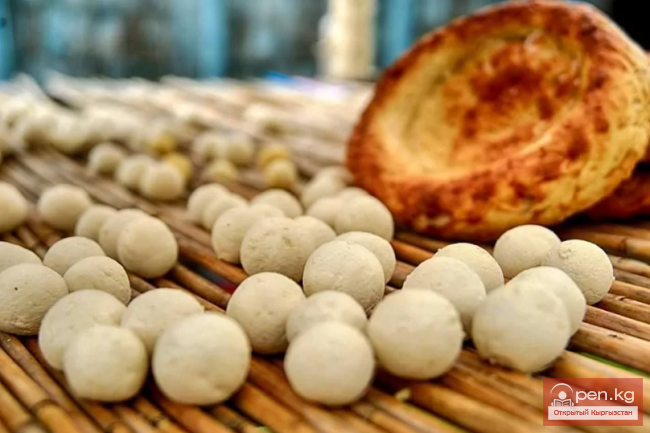
Tanning of Suede.
For this purpose, the skins of sheep, goats, mountain goats, and roe deer were used. The skin of the latter was valued significantly higher due to its durability and water resistance. "Kyrgyz people highly value the skin of kiyika because the strongest and most waterproof chombars are made from it. Chombars made from any other skin get wet even from rain, while in kiyika chombars, one can safely float on water without getting wet." After soaking in a saline solution, the skin was placed in a solution of alum (“achyk tash”), where it softened over several days.
Even greater softness was achieved by prolonged kneading by hand.
After cleaning and kneading, the skin was dyed. In the past, skins were dyed with natural dyes (usually using rhubarb root and pomegranate peels) in yellow and orange colors.
The dyes were boiled, and the cooled solution was mixed with the infusion formed after boiling and settling of the alum, along with vegetable oil (usually flaxseed) or melted cow's fat. The mixture was poured into a large container, and the skin was kept in it for two to four days. Another dyeing method involved repeatedly applying a saturated dye solution to the skin, which then acquired the desired color that remained stable.
Leather vessels intended for storing dairy products, as well as various leather bags for wooden dishes, were first smoked in specially arranged smokehouses — ystadym. Usually, several families shared one smokehouse, and in small villages, anyone could use it. In the south, simpler and smaller smokehouses have survived compared to those of the northern Kyrgyz.
The depth of the smokehouse pit, where the vessels are placed, does not exceed one meter: the channel through which the smoke passes has a diameter of 50-60 cm and a length of one and a half to two meters. On the "jailoo," we encountered even more primitive smokehouses set up by each family. They are small, in the form of a pit (50-60 cm deep, 30-35 cm wide), where fuel is placed at the bottom. Sticks are set above the pit for hanging the vessel intended for smoking. Smoking lasts for a day.
Like every item in everyday life, the Kyrgyz sought to decorate their leather products. They were decorated in various ways. Silver plaques adorned harness accessories, cases for bowls were embroidered or patterns were attached through appliqué. Items were given original shapes, for example, anchor-shaped for koyekor, hemispherical or cylindrical for cases that held bowls. An especially original decoration is the application of patterns directly onto the leather. They enliven the monochrome surface of the leather and give it greater appeal.
According to our observations, there are two methods of applying ornamentation to leather: drawing (tracing) and embossing. These ornamentation methods differ in technique and, likely, in origin. The drawing of patterns should be considered the more ancient method. It is used only for vessels for kumys (koyekor, kyonok), which are sewn from leather processed at home. Patterns were applied with a pointed stick on the damp surface of the finished vessel, which was previously filled with sand. This created a pattern of contoured indented lines. The Kyrgyz masters call this method of applying patterns oyum chiyim (drawing). The patterns consist of curls, concentric circles, or squares with rounded corners. The shape of the vessels, the technique of applying patterns, and their motifs reveal a complete analogy with those of the Kazakhs, Altai people, and Mongols, and their development should be traced back to a common origin.
The technique of embossing is of a different nature. It was used for ornamenting only well-tanned leather "bulgaary," which covered saddles, horse blankets, and cases for bowls. Embossing on leather processed by primitive home methods is not common. Wooden patterned stamps with carved ornamentation were used for embossing. The damp leather was placed on the stamp and pressed into the indentations. As a result, raised lines of ornamentation appear on the front side of the leather. The pattern of embossing is usually strict, symmetrical, consisting of smooth curves, curls, parallel lines, and S-shaped figures. In the 19th century, among the northern Kyrgyz, as well as among the Kazakhs, embossing on leather was widespread. In southern Kyrgyzstan, it found greater application in the eastern part. It is worth noting that the ornament and stencils for embossing on leather among the Mongols are similar to those of the Kyrgyz.
Technology of Processing Livestock Raw Materials among the Kyrgyz of the Past Century














































